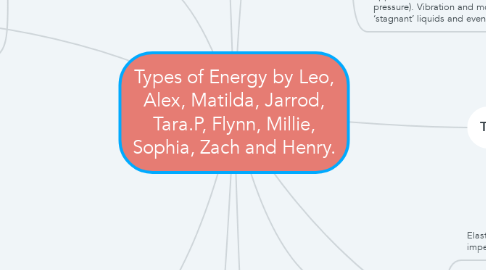Types of Energy by Leo, Alex, Matilda, Jarrod, Tara.P, Flynn, Millie, Sophia, Zach and Henry.
저자: Leonardo Maraventano


1. Gravitational
1.1. Potential energy relative to the objects position above earth
1.2. Released when it drops, as gravity brings it down and the higher the object is, the more energy it possesses
2. Chemical
2.1. Potential energy, meaning that it is stored and can be released later
2.2. The energy is the potential of chemicals to go through a chemical reaction to become usable energy. Food goes through the process of digestion, turning the potential energy into kinetic. Combustion turns fuel into heat and light energy, changing it from potential to kinetic energy
3. Radiant
3.1. Radiant energy is energy that is contained in electromagnetic waves.
3.2. The electromagnetic waves include visible light, infrared, radio waves, ultraviolet and microwaves. Thermal energy, or heat energy.
3.3. Radiant energy is able to travel through space.
3.4. The Sun produces a lot of radiant energy which is transmitted to Earth as light.
4. Potential
4.1. definition: potential energy is the energy held by an object because of its position relative to other objects, stresses within itself, its electric charge, or other factors.
4.2. Potential energy is essentially what it sounds like, though there are a few intricacies involved. The actual potential energy of an object depends on its position relative to other objects.
4.3. A brick has more potential energy suspended off of a two-story building than it does resting on the ground. That's because the brick's relative position to the Earth gives it more energy.
4.4. A large sandstone boulder rests precariously over a steep slope. The boulder has potential energy relative to the slope, as it appears to be ready to fall at any moment and slide hundreds of feet into the valley below.
5. Electrical
5.1. What is it? Electrical energy is better known as electricity, electricity is energy from using potential and kinetic energy to gather electrons. When the electric charge is gathered by the charged particles whilst it is conducted through wire to.
5.2. Modern examples: The world is filled with examples of electrical energy, for example an electric stove, lamp, heater, tv, xbox, fan or any other appliances in your house.
5.3. How does it work? Electrical energy is gathered via potential and kinetic energy. The electrical charge created by potential and kinetic energy is carried through wire to power whatever they are connected to.
6. Kinetic
6.1. Kinetic energy is the energy transferred or ‘generated’ when force is applied to a mass. The amount of kinetic energy depends on many variables.
6.2. Everday Examples
6.2.1. Walking
6.2.2. waving
6.2.3. talking
6.2.4. picking something up
6.2.5. Pushing
6.2.6. Driving
